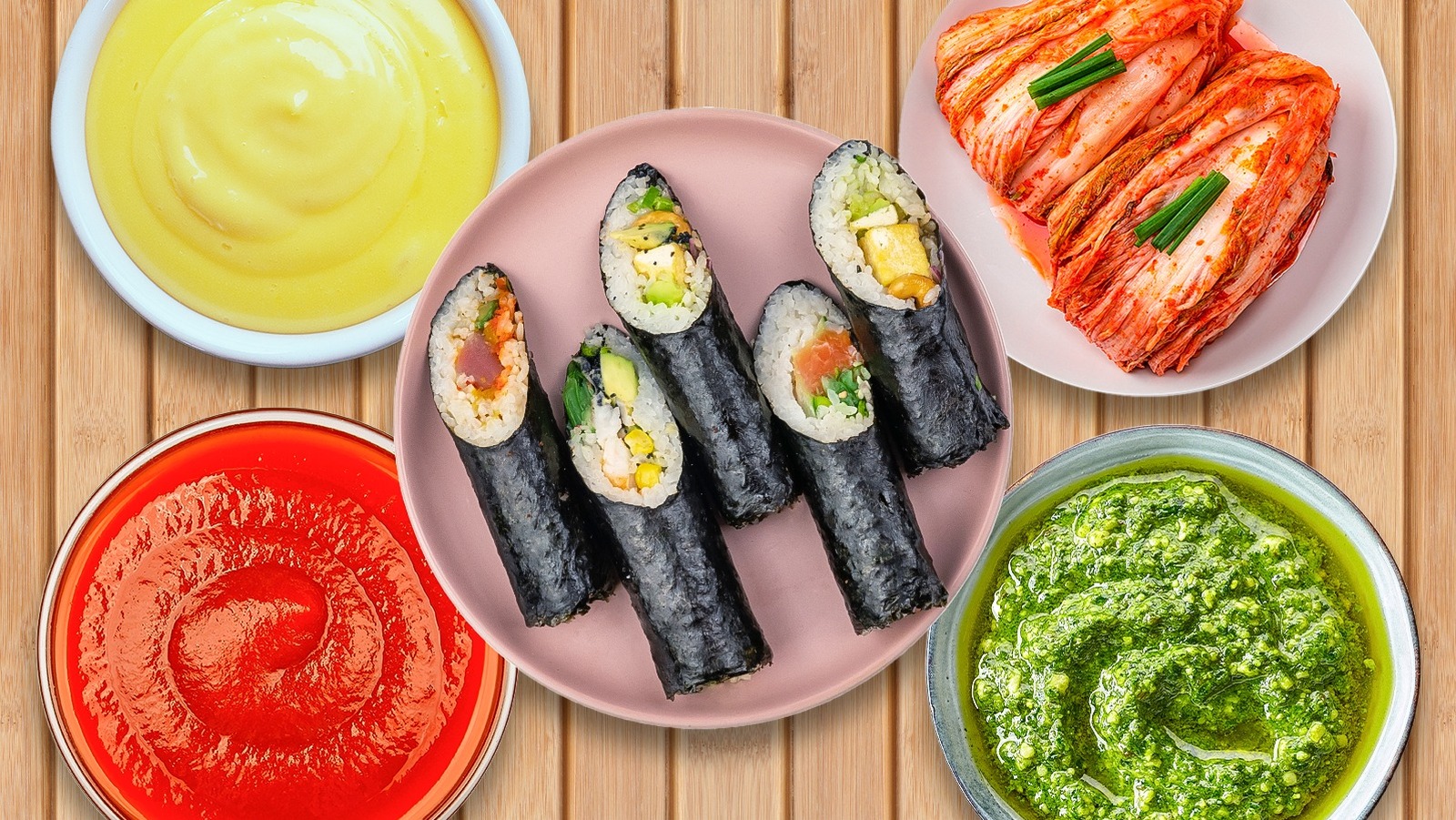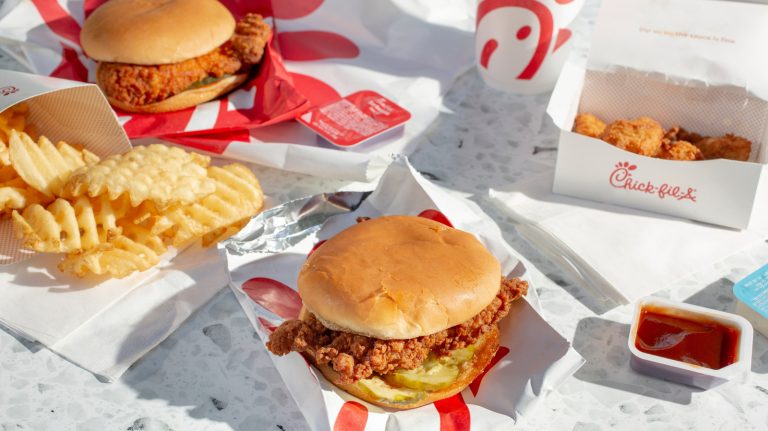There’s traditional sushi, with its intricate presentation and bite-sized pieces, and then, there’s the sushi burrito. When you’re craving the delicious, fresh flavors of this Japanese staple in a quicker-to-make, more generous, and more portable form, burrito-fying your sushi is the solution. Prepping a sushi burrito is a far more casual affair than crafting your typical batch of sushi rolls. Its larger size means more room for those all-important add-ins, and, there’s less worry about arranging your fillings in a certain way, or getting that roll perfectly neat. This fun fusion dish is incredibly easy to customize to your taste and different dietary needs, too.
A sushi burrito generally begins with a sheet of nori (or two attached together with a simple brush of water!). It’s then topped with an even layer of seasoned sushi rice, before placing the fillings in the center, and rolling everything up. Making a sushi burrito offers the perfect opportunity to experiment with colorful, flavorful filling ingredients, with plenty of room for creativity. Of course, there are all the sushi classics, like sushi-grade raw fish, avocado, cucumber, or shredded carrot. But if you’re in the mood for something a little more unique, we’ve got you.
From flavor-packed sauces to zesty herbs and even sweet fruits, the following list is packed with tasty ways to upgrade your next sushi burrito creation. Whether you’re looking to elevate your homemade dish with an elegant final touch, pack in some extra nutrition, or switch up the rice for something more vibrant, there’s an ingredient to fit your needs. So, let’s get rolling.
Kimchi
Tangy, crunchy, and great for your gut, kimchi makes for a wonderful addition to any sushi burrito. This traditional Korean side dish consists of vegetables, such as napa cabbage, that have been fermented with a range of aromatics, herbs, and spices. The resulting kimchi has a distinctly sour, spicy, and salty taste. It’s loaded with live probiotic bacteria, and eating it can help to support a diverse gut microbiome, which has been linked to various aspects of good health. You can either pick up a handy tub or jar of store-bought kimchi, or have a go at making your own. Just bear in mind that you’ll need to factor in at least three days of fermentation time before you can eat it.
When building your sushi burrito, combine your kimchi with a medley of other complementary fillings. It’ll pair fantastically with a range of savory proteins such as chicken, salmon, tuna, and tofu. Its spicy tang is great for balancing creamy ingredients like avocado or mayonnaise, and it provides a satisfyingly crunchy textural contrast to the sticky rice and soft nori. You can always continue the spicy theme by enhancing your sushi burrito with a drizzle of hot sauce and a dollop of gochujang paste.
Pesto
Whilst it’s more commonly reserved for Italian-inspired dishes, pesto absolutely deserves a place in your sushi burrito. It’s a pretty transformative add-in, boasting a vibrant green color and plenty of rich, herbaceous flavor. This is the perfect ingredient if you’re looking to switch things up from the traditional Japanese-inspired flavors and give your sushi burrito a bright, zesty twist.
Make your own pesto, but there’s no shame in reaching for a store-bought pesto if you’re short on time. You can also add some capers for an extra hit of briny goodness. This sauce works great alongside slices of chicken breast and fresh, crunchy veggies like bell peppers, tomatoes, and cucumber. You could also try mixing drained, canned tuna with some spicy mayo and spooning this over the sushi rice alongside the pesto sauce. To continue the herby theme, try adding some chopped fresh dill, cilantro, or basil. Or, to turn up the heat, incorporate some pickled jalapeño slices into the burrito.
Aioli
Rich, creamy, and loaded with garlicky goodness, aioli can elevate just about any dish, including a sushi burrito. A simple spread of this sauce will impart a welcome dose of aromatic flavor that can take the overall vibe of your burrito from basic to irresistible.
For maximum freshness and the ability to adjust the amount of garlic to your taste, we highly recommend making aioli from scratch. This requires just five minutes of your time and will leave you with a batch of sauce that can be added to a variety of other dishes throughout the week. There’s also the option to spice up your aioli with some fiery additions, such as a spoonful of gochujang paste or a sprinkling of cayenne pepper.
Before you add the aioli to your burrito, let it sit for at least an hour so those wonderful flavors can meld. The resulting sauce will be amazingly versatile, working just as well alongside hearty and umami-rich additions as it will with light, fresh vegetables, fruits, and herbs.
Fresh dill
When you’ve got your protein and veg-based fillings sorted, but want to spruce things up with a final touch of freshness, dill is an excellent option. Add a few sprigs of this herb to your sushi burrito, and it’ll bring a subtle citrusy brightness that enhances the taste of other ingredients without overpowering them.
Dill is a notoriously fitting accompaniment to fish, particularly salmon and trout, where the herb’s refreshing flavor profile can balance the richness of the oily, flaky fish beautifully. Dill will also taste fantastic with zesty add-ins like lemon or lime juice, leafy greens such as spinach, lettuce, and cabbage, as well as creamy ingredients — think cream cheese or Kewpie mayo. Finely sliced raw onions or even pickled onions are great choices for adding some complementary tang. And, you can totally pair dill with other herbs. Try throwing some mint, cilantro, or parsley into your burrito, too.
Pickled ginger
Pickled ginger is arguably one of the most classic sushi pairings, and for that reason, we quite simply couldn’t leave it off this list. Known as “gari” in Japanese cuisine, pickled ginger often comes included with your sushi in restaurants, where it functions as a palate cleanser between bites. You’ll notice that this tangy condiment is sometimes bright pink in color, which, of course, is not the ginger’s natural shade. Whilst ginger will take on a soft pinkish hue as it reacts with vinegar during the pickling process, if it has a distinctly bold appearance, it’s most likely been enhanced with dye.
You can buy jars of pickled ginger in most large grocery stores and Asian supermarkets, but making your own is a fuss-free option too. Pickled ginger will shine with a range of traditional sushi fillings. Try building a classic ginger-infused sushi burrito by pairing the pickled slices with sushi-grade salmon and tuna, sliced avocado, lettuce, cucumber, carrot, and your favorite sauces. It’s also great with mild and nutty edamame beans, which can be shelled and scattered over the burrito’s rice layer. The pickled ginger’s fiery tang balances sweet fruits like pineapple or mango brilliantly, too. You can use the condiment as part of a selection of other pickled veggies, such as daikon radish, cucumber, or eggplant.
Toasted sesame seeds
Another staple in Japanese cuisine, toasted sesame seeds add plenty of crunch and moreish nutty flavor to a sushi burrito. These work exceptionally well as a final addition before rolling everything up, to create a well-rounded taste and texture.
Grab some pre-toasted seeds at the store, or toast your own. Don’t be tempted to skip the toasting step, as this intensifies the natural nuttiness of the seeds. To do this, add the sesame seeds to a hot, dry skillet and swirl them for three to four minutes until evenly browned. Alternatively, spread them out on a baking sheet and pop them into a preheated oven for five to six minutes, stirring halfway through. The toasted seeds can then be transferred to an airtight container and stored at room temperature for up to a week, or in the fridge for three months.
With the toasted sesame seeds ready for sprinkling generously into your sushi burrito, continue the crunchy theme with some complementary fillings, such as crispy onions, carrot sticks, or panko-coated proteins. Your finished burrito will also taste great with a sesame-based dipping sauce, whether that’s one made with creamy tahini or a deeply nutty toasted sesame oil.
Sriracha
If including a spicy element in your sushi burrito is a non-negotiable, using sriracha is one of the simplest and most effective methods. This fiery sauce adds a punchy dose of heat, bringing some excitement to your homemade creation and serving as an excellent contrast to other cooling and creamy add-ins.
To add sriracha to your sushi burrito, simply drizzle a generous layer on top of your fillings, as the last step before rolling up the nori. It’s wonderfully versatile, fitting in seamlessly with an array of other sweet, savory, and tangy ingredients. To really amp up the spice level, you could throw in some bold accompaniments, such as pickled jalapeño slices, gochujang-marinated proteins, or a scattering of red pepper flakes. Or, to tone down the heat slightly, try mixing your sriracha with mayonnaise and a squeeze of lime before drizzling it onto the burrito. Acidic ingredients like lemon juice or vinegar are great for cutting through the spiciness, too.
Chicken katsu
Simple sliced or shredded chicken is an ideal protein option for filling your sushi burrito, but to make things even tastier and crispier, why not upgrade this to chicken katsu? This dish sees chicken thighs coated in a delightfully crunchy layer of panko breadcrumbs, usually with a tangy sauce drizzled on top. And, as chicken katsu is typically paired with rice, adding it to a sushi rice-filled burrito seems like a natural fit.
Making your own chicken katsu is easier than you’d think, with chicken thighs pounded flat, dredged in flour, egg, and panko breadcrumbs, and deep fried until golden and crisp. To add it to your sushi burrito, cut the chicken katsu into thin slices that’ll fit snugly into the rice-filled nori. If you’d like, prepare the traditional accompaniment of tonkatsu sauce and drizzle this mixture on top of the crispy chicken. Or, go for a dollop of creamy Kewpie mayo. For veggies, shredded cabbage or thin ribbons of carrot or cucumber would be ideal accompaniments, and something tangy, such as a scattering of pink pickled onions or pickled ginger, would be a brilliant final touch here, too.
Mango
Vegetables and herbs aren’t the only options for adding freshness to a sushi burrito. Sweet, juicy fruits like mango can also make excellent filling choices, especially when used in unison with contrasting, umami-rich ingredients. Just peel and slice up this sunny fruit, and lay the pieces onto the rice-topped nori sheet. It’ll fit in beautifully with chicken, tuna, salmon, or tofu. Try marinating your protein in a soy or miso-based sauce for the ultimate sweet-salty balance. And, when it comes to veggie fillings, choose from the classics, like sliced cucumber, shredded carrot, or chopped green onions. You could even throw in some toasted peanuts for added crunch. Don’t forget to finish with a drizzle of your favorite sauce, such as a spicy mayo or even a zesty ponzu.
Another delicious way to incorporate mango into your sushi burrito is in the form of a vibrant salsa. Try dicing the mango up into small cubes, and tossing it with finely diced red onion, cherry tomatoes, fresh serrano chili, and chopped cilantro, plus a good pinch of salt and a squeeze of lime juice. This fruity mixture will taste incredible with slices of seared tuna steak and a cilantro cream sauce, for a fish taco-inspired sushi burrito.
Fish roe
For a gourmet-style sushi burrito, consider adding some fish roe into the mix. Roe is essentially the unfertilized eggs of a fish, and there are several varieties to choose from. These are categorized by the specific species of fish that they come from. For example, there’s the highly prized caviar, which is harvested from the sturgeon fish, and masago of the capelin fish. Tobiko, on the other hand, comes from the flying fish. These tiny eggs have a melt-in-the-mouth texture and subtle, briny taste, with the exact flavor profile varying somewhat depending on the specific variety.
Fish roe is a popular addition to sushi rolls, with the vivid orange color of masago and tobiko making an eye-catching garnish or coating. But it’ll work just as well in a heartier sushi burrito. Spoon in as much fish roe as desired, and go all out with a diverse medley of other fillings. Focus on creating a balance of different flavors and textures, such as crispy fried onions, creamy avocado, spicy pickled jalapeños, tangy kimchi, and delicately salty raw fish.
Purple rice
When it comes to the rice element of your burrito, you don’t have to stick to plain old white sushi rice. To give your meal a seriously jazzy upgrade, try swapping in purple rice. The vivid violet color of this rice comes from antioxidant pigments called anthocyanins, which also boast several health benefits. As well as helping to fight harmful free radicals in the body, consuming anthocyanins may also bring down inflammation, support heart health, and reduce the risk of developing certain types of cancers. So, it’s not just visual appeal that this unique add-in can bring.
Purple rice, which is sometimes also referred to as forbidden rice, is prepared by boiling a mixture of black glutinous rice and short grain white rice together in the same pot. Once cooked, it has a subtle nutty flavor and slightly firm, chewy texture that’s not quite as sticky as traditional sushi rice. Feel free to season the purple rice with a splash of rice vinegar and a sprinkle of sugar, then simply layer it on top of the nori just as you would with the classic version. For the ultimate aesthetically pleasing result, top it with fillings that have contrasting colors, like bright orange carrots, green onions, and red bell peppers.
Shiso leaves
Shiso, or perilla, is a fresh herb with a bright, citrusy flavor. The leaves come in green or red varieties, and they’re traditionally served with sushi or sashimi, with their large size being ideal for wrapping around bite-sized portions of rice and fish before eating. They’re also often added to Japanese bento boxes, where they act as separators between the various elements inside.
These refreshing leaves can be added whole, arranged in an even layer on top of other fillings, or chopped finely before adding for a more even flavor distribution. Pairings-wise, they’re the perfect addition to slices of rich salmon or tuna, as well as fresh fruits and veggies like mango, radish, or even sautéed mushrooms. You could even try making shiso tempura by dipping the leaves into batter and deep-frying them until crisp. This way, you can add both flavor and crunch to your sushi burrito.
You’ll find shiso leaves at many large Asian grocery stores. A bunch will last for around four days if stored in the fridge. If you don’t plan to use them up within this time frame, you can always buy them in a more convenient, longer-lasting form, such as dried, frozen, or packed in oil.
Roasted red peppers
Sweet, vibrant, and packed with caramelized flavor, roasted red peppers are a must-try sushi burrito add-in. Their natural sweetness is great for enhancing the savory richness of meat and fish ingredients and balancing spicy elements. Plus, they make for a fun alternative to your usual crunchy salad veggies.
Go for the convenience of pre-roasted, jarred red peppers, which will need a quick drain and slice before adding to your sushi burrito. Or, go ahead and roast your own. Your best bet is to cut each roasted pepper into several long, thin strips, which can be laid across the length of the nori sheet. They’ll fit in seamlessly with a variety of proteins, including tofu, shrimp, shredded chicken, and tuna, as well as salty additions such as crunchy roasted peanuts. For a fresh element, consider tossing in some vibrant sprouts or microgreens. As you craft your sushi burrito, consider pairing the sweet peppers with a fiery, ginger-infused guacamole or some spicy jalapeños for a pleasing flavor contrast.





